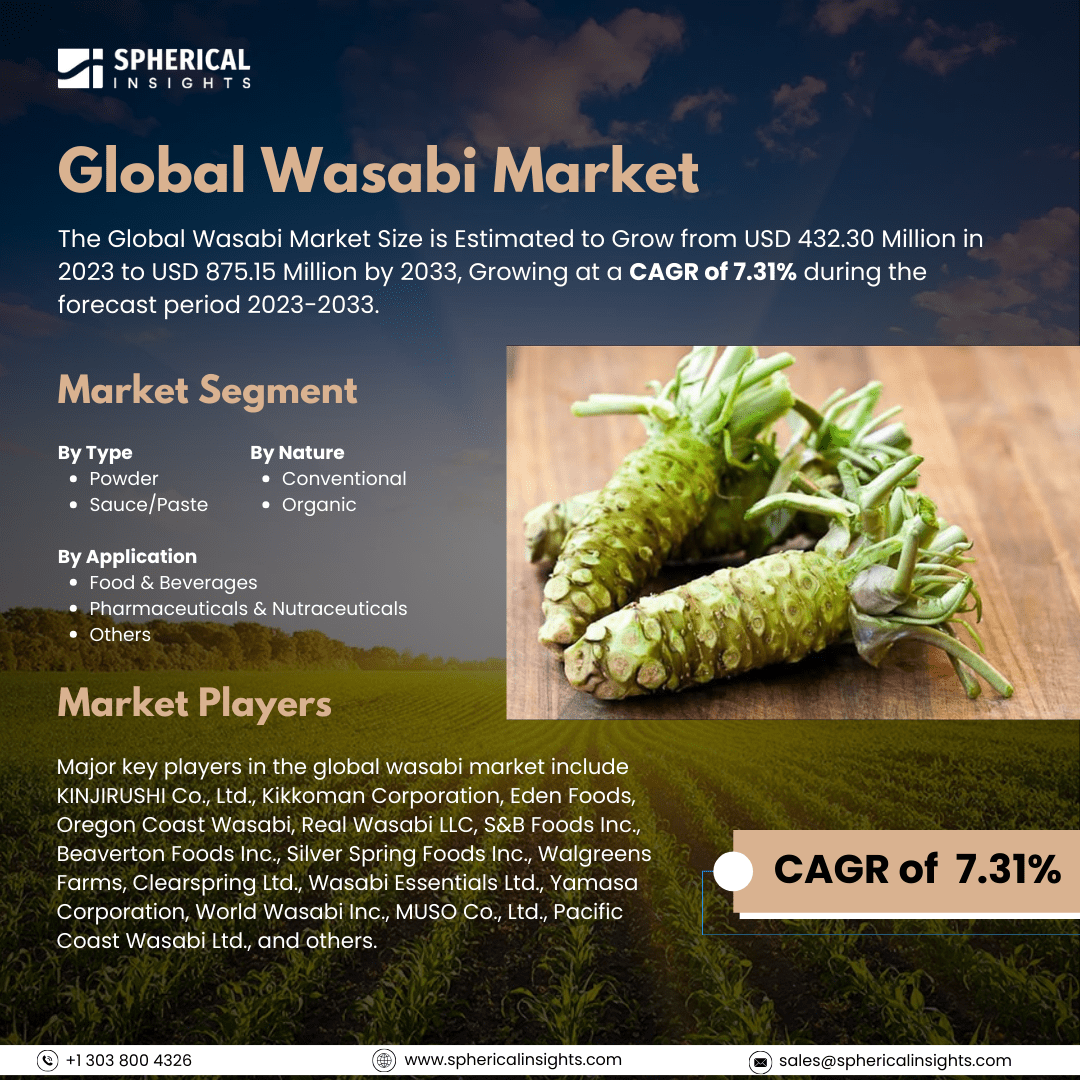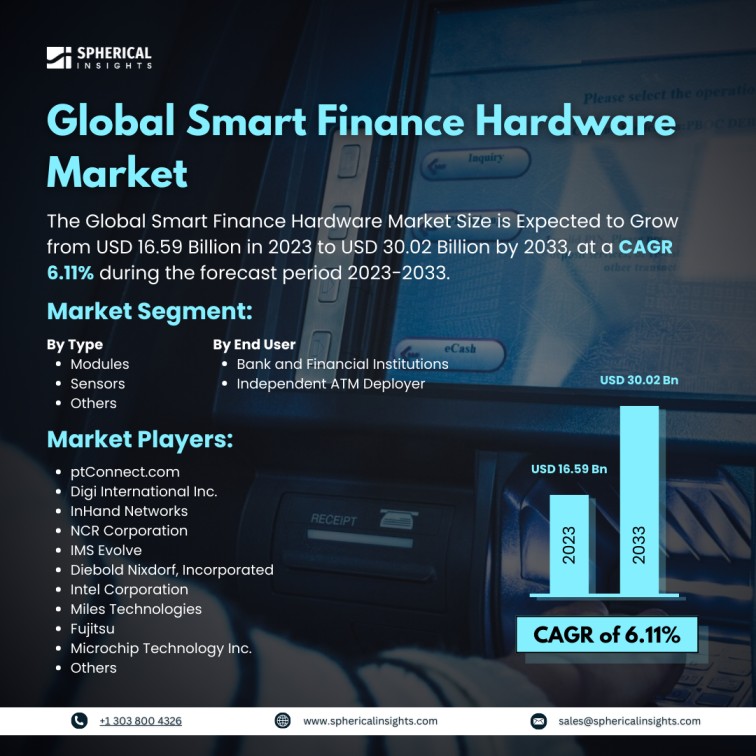Global Wasabi Market Size to Worth USD 875.15 Million by 2033
According to a research report published by Spherical Insights & Consulting, The Global Wasabi Market Size is Estimated to Grow from USD 432.30 Million in 2023 to USD 875.15 Million by 2033, Growing at a CAGR of 7.31% during the forecast period 2023-2033.
Browse key industry insights spread across 215 pages with 110 Market data tables and figures & charts from the report on the Global Wasabi Market Size, Share, and COVID-19 Impact Analysis, By Type (Powder and Sauce/Paste), By Nature (Conventional and Organic), By Application (Food & Beverages, Pharmaceuticals & Nutraceuticals, and Others), and By Region (North America, Europe, Asia-Pacific, Latin America, Middle East, and Africa), Analysis and Forecast 2023 – 2033.
The market for the spicy green condiment created from the Japanese horseradish plant, Wasabia japonica, is known as the global wasabi market. Growing consumer awareness of wasabi's health benefits which include antimicrobial and anti-inflammatory qualities that help prevent cancer and heart disease, and improve gut health is one of the main factors driving the market's notable growth. As consumers become more health-conscious, they look for natural ingredients that provide these benefits, which has led to a surge in wasabi's appeal in culinary applications in addition to traditional Japanese dishes such as sushi and sashimi. The market's expansion is also being driven by the rising demand for Japanese food around the world. Genuine wasabi has become more and more necessary as a condiment as more people are exposed to Japanese cuisine, especially in North America and Europe. Wasabi products are becoming more and more popular as a result of the growth in Japanese restaurants. This isn't only a trend in fine dining; it's also seen in grocery shops and informal restaurants where customers can purchase wasabi products to use at home. Improving the wasabi supply chain also requires technological developments in cultivation and processing techniques. By increasing output and quality, innovations in agricultural practices are facilitating producers' ability to satisfy growing demand. However, the high cost of producing wasabi is one of the main obstacles.
The sauce/paste segment held the largest share in 2023 and is expected to grow at a CAGR of 5.52% throughout the projection period.
Based on the type, the global wasabi market is categorized into powder and sauce/paste. Among these, the sauce/paste segment held the largest share in 2023 and is expected to grow at a CAGR of 5.52% throughout the projection period. The wasabi sauce and paste market is expanding significantly due to several important causes. One of the main factors is the growing global appeal of Japanese food. Authentic wasabi goods, such as paste and sauces, are in high demand as sushi and other Japanese cuisine become more popular in other parts of the world. This trend is especially notable in North America and Europe, as more and more Japanese eateries and fusion restaurants are adding wasabi to their menus, increasing their exposure and consumption among a wider range of consumers.
The conventional segment dominated the largest share in 2023 and is anticipated to grow at a significant CAGR during the forecast period.
Based on the nature, the global wasabi market is classified into conventional and organic. Among these, the conventional segment dominated the largest share in 2023 and is anticipated to grow at a significant CAGR during the forecast period. Conventional wasabi products come in handy forms such as tubes and packages and are easily found in supermarkets. For the majority of customers, this makes them an ideal option. For many consumers, pricing is a key determining factor, especially when it comes to condiments consumed in tiny quantities. Compared to organic wasabi, conventional wasabi is significantly less expensive while still providing a similar flavour.
The food & beverages segment accounted for the largest share of 68.56% in 2023 and is estimated to grow at a CAGR of 4.95% throughout the projection period.
Based on the application, the global wasabi market is divided into food & beverages, pharmaceuticals & nutraceuticals, and others. Among these, the food & beverages segment accounted for the largest share of 68.56% in 2023 and is estimated to grow at a CAGR of 4.95% throughout the projection period. One of the main causes is the growing desire for Japanese cuisine worldwide, especially sushi, which has become a mainstay in many non-Japanese nations. Sushi restaurants are proliferating, and Japanese flavours are becoming more and more ingrained into regular cooking techniques. Additionally, consumers' awareness of wasabi's health advantages is growing, which adds to its allure. This pattern is consistent with the larger trend of eating better, which has been demonstrated to support the growth of the market.
Asia Pacific is expected to hold the largest share of the global wasabi market through the forecast period.
Asia Pacific is expected to hold the largest share of the global wasabi market through the forecast period. Demand is still fueled by the region's widespread cultural connection to wasabi, particularly in traditional Japanese cooking. In addition to its use in cuisine, wasabi is also being utilized more and more in South Korea and China in nutraceutical products and health supplements. Technological developments in wasabi farming, such as hydroponic farming methods, are also contributing to the growth of the wasabi market in Asia-Pacific by improving production efficiency and satisfying the rising demand for real wasabi.
North America is predicted to grow at the fastest CAGR of the global wasabi market over the forecast period. The market is driven by the growing appeal of Japanese food and sushi in the US and Canada. Wasabi is a popular choice in both home kitchens and restaurants due to the region's unique culinary culture and consumers' desire to try new flavours. Growing knowledge of wasabi's health advantages is extending its use in wellness and nutraceutical goods beyond its use in food. Supermarkets and e-commerce sites are part of North America's robust retail infrastructure, which has made Wasabi products easily accessible and contributed to the market's expansion.
Company Profiling
Major key players in the global wasabi market include KINJIRUSHI Co., Ltd., Kikkoman Corporation, Eden Foods, Oregon Coast Wasabi, Real Wasabi LLC, S&B Foods Inc., Beaverton Foods Inc., Silver Spring Foods Inc., Walgreens Farms, Clearspring Ltd., Wasabi Essentials Ltd., Yamasa Corporation, World Wasabi Inc., MUSO Co., Ltd., Pacific Coast Wasabi Ltd., and others.
Recent Developments
- In June 2022, Shima Wasabi, a Tasmanian commercial wasabi farm, revamped its online store to highlight the advantages of real wasabi. In addition to paste and powder jars, the updated online store will provide fresh wasabi stems and leaves. Chefs, mixologists, restaurants, and distilleries across Australia are interested in its products, the company claims.
Key Target Audience
- Market Players
- Investors
- End-users
- Government Authorities
- Consulting And Research Firm
- Venture capitalists
- Value-Added Resellers (VARs)
Market Segment
This study forecasts revenue at global, regional, and country levels from 2023 to 2033. Spherical Insights has segmented the global wasabi market based on the below-mentioned segments:
Global Wasabi Market, By Type
Global Wasabi Market, By Nature
Global Wasabi Market, By Application
- Food & Beverages
- Pharmaceuticals & Nutraceuticals
- Others
Global Wasabi Market, By Regional Analysis
- North America
- Europe
- Germany
- UK
- France
- Italy
- Spain
- Russia
- Rest of Europe
- Asia Pacific
- China
- Japan
- India
- South Korea
- Australia
- Rest of Asia Pacific
- South America
- Brazil
- Argentina
- Rest of South America
- Middle East & Africa
- UAE
- Saudi Arabia
- Qatar
- South Africa
- Rest of the Middle East & Africa



